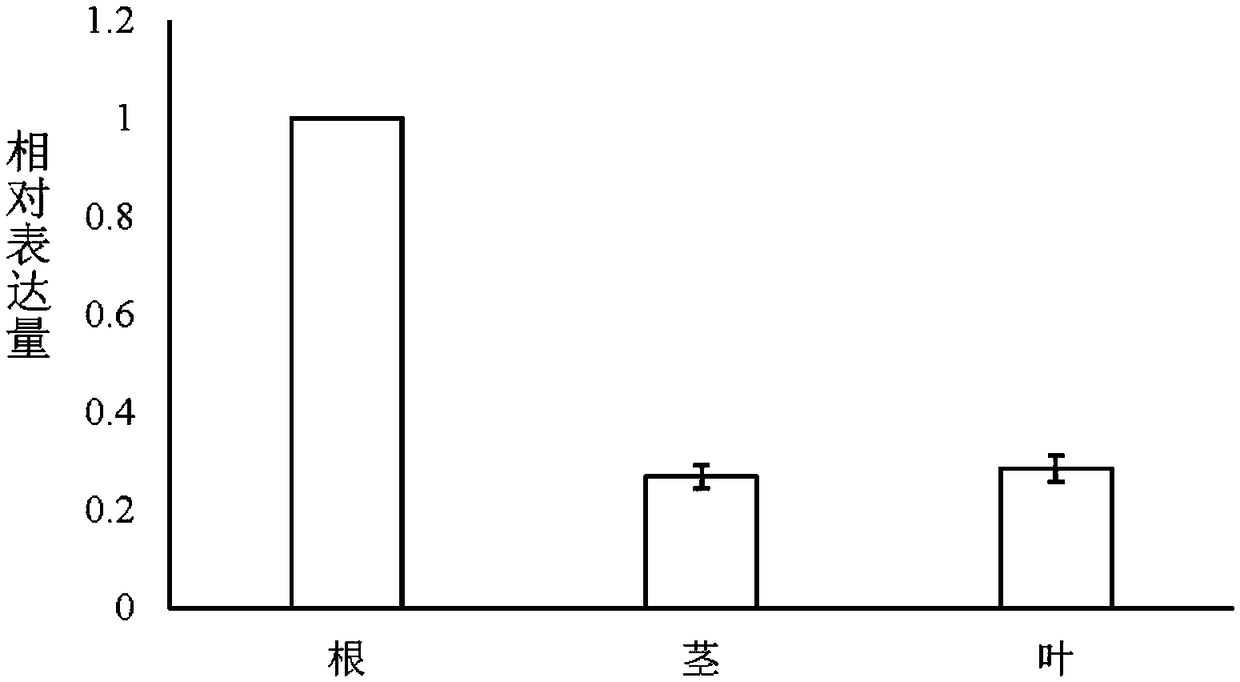Verticillium wilt resistant associated protein GbVIP1, coding gene and application thereof
A technology of resistance to verticillium wilt and related proteins, applied in the fields of application, genetic engineering, plant genetic improvement, etc., can solve the problems of long breeding cycle, lack of germplasm resources, and inability to popularize large-scale sea island cotton with resistance to verticillium wilt
- Summary
- Abstract
- Description
- Claims
- Application Information
AI Technical Summary
Problems solved by technology
Method used
Image
Examples
Embodiment 1
[0037] Cloning, sequence and expression analysis of embodiment 1GbVIP1 gene
[0038] Plant the sea-island cotton variety Hai 7124, take cotton leaves at the seedling stage, grind the cotton leaves into powder with liquid nitrogen, use the EASYspin Plus Plant RNA Rapid Extraction Kit (Adelaide) to extract total RNA from cotton leaves, and use the reverse transcription kit (TakaRa) cDNA was synthesized.
[0039] The synthesized cDNA was used as a template to amplify GbVIP1, and the primer sequence used was F: 5'TACGCCGCCGCTTCTTCCGCCTACA3'; R: 5'CTTACCAAGCATTTCCTTCCAACAT3' (as shown in SEQ ID NO: 3-4).
[0040] Use high-fidelity Taq enzyme KOD-Plus-Neo (TOYOBO) to amplify GbVIP1, the 20ul reaction system is as follows, 10×PCR buffer for KOD-Plus-Neo, 0.2mM dNTPs, 1.5mM MgSO 4 , 0.3uM forward primer and 0.3uM reverse primer, 0.4U KOD-Plus-Neo, 200mM cDNA, the amplification program was 94°C for 4min, 98°C for 10s, 60°C for 1min, 68°C for 1min; 34 cycles, 68°C for 5min, Take the amp...
Embodiment 2
[0043] The acquisition of the expression vector of embodiment 2GbVIP1 gene, recombinant expression cell and transgenic tobacco
[0044] Construct the GbVIP1 gene into the expression vector pBI121 to obtain a recombinant expression vector, start the expression of the gene with the 35S promoter, terminate the expression of the gene with the NOS terminator, and use the kanamycin gene as a screening marker. The specific method is as follows, using Example 1 The resulting recombinant vector GbVIP1-pLB was used as a template, with primers F: acgggggactctagaggatccTACGCCGCCGCTTCTTCC, R: cgatcggggaaattcgagctcCTTACCAAGCATTTCCTTCCAAC (as shown in SEQ ID NO: 7-8) amplified to obtain the PCR product of the GbVIP1 gene sequence, and using the restriction enzyme SacI The pBI121 vector was digested with BamHI to obtain a linearized plasmid with a restriction site, and the PCR product was constructed into the overexpression vector pBI121 using a homologous recombination kit (ClonExpress II OneS...
Embodiment 3
[0054] Functional analysis of embodiment 3GbVIP1
[0055] (1) Analysis of the expression pattern of GbVIP1 gene after cotton was inoculated with Verticillium dahliae
[0056] Cotton is grown by hydroponics, and the concentration of spores is 1*10 at the stage of two leaves and one heart 7 Cotton Verticillium dahliae Vd853 used the root dipping method to infect the roots of cotton seedlings, then respectively got the root tissue of 0h, 6h, 12h, and 24h cotton seedlings after inoculation, and utilized the method described in Example 1 to extract RNA and reverse It was transcribed into cDNA, and the expression of GbVIP1 gene after cotton was inoculated with Verticillium dahliae was studied by real-time PCR. See Example 1 for the primers and reaction system used. The results found that the expression level of GbVIP1 gene was up-regulated after inoculation, and the expression level of GbVIP1 gene was the highest at 6h after inoculation, which was 3.73 times that of the control ( ...
PUM
 Login to View More
Login to View More Abstract
Description
Claims
Application Information
 Login to View More
Login to View More - R&D
- Intellectual Property
- Life Sciences
- Materials
- Tech Scout
- Unparalleled Data Quality
- Higher Quality Content
- 60% Fewer Hallucinations
Browse by: Latest US Patents, China's latest patents, Technical Efficacy Thesaurus, Application Domain, Technology Topic, Popular Technical Reports.
© 2025 PatSnap. All rights reserved.Legal|Privacy policy|Modern Slavery Act Transparency Statement|Sitemap|About US| Contact US: help@patsnap.com



